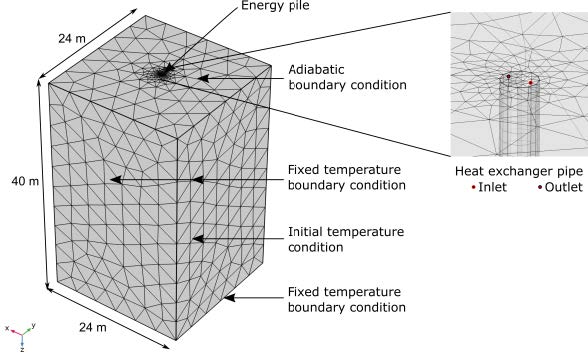Master projects
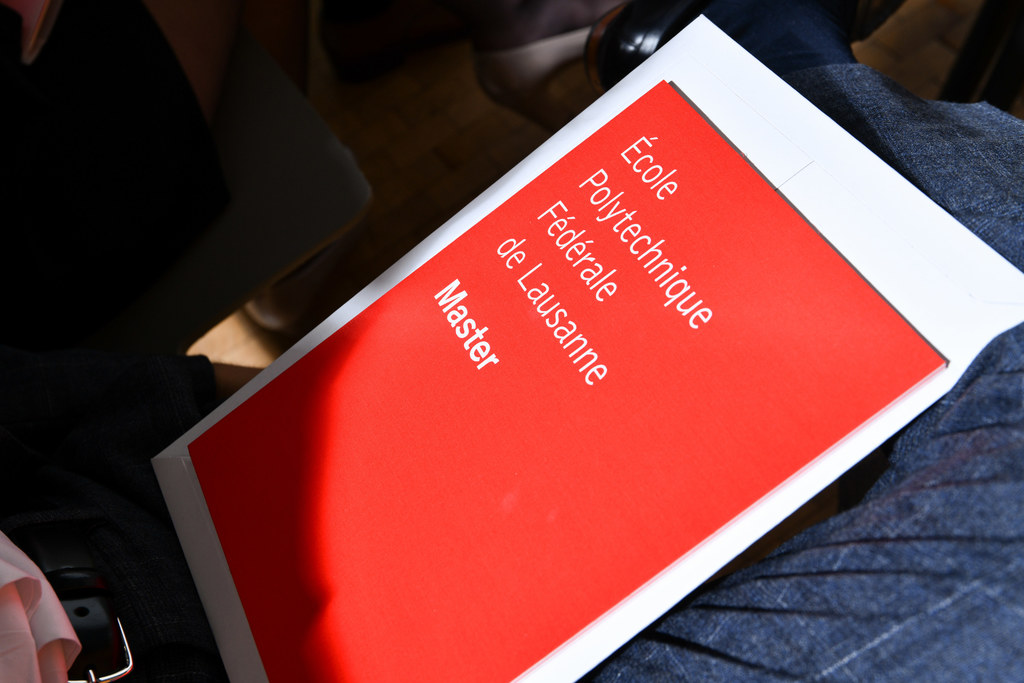
Master project proposals – spring semester 2025
In order to submit the project or for any questions please contact the supervisor(s) of the project or Prof. L. Laloui.
Please note that any project can be adapted to fit a semester project. To arrange that, please contact the supervisor with Prof. Lyesse Laloui and Ziad Sahlab in copy.
Energy Geostructures
The following 2 topics are proposed by Dr. Angelica Tuttolomondo.
-
Boreholes for geo-energy applications: a numerical study.
Documentation -
Underground stress state assessments for geo-energy applications.
Documentation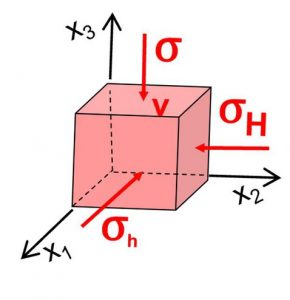
Tasks
– understanding and compiling the requirements for the technical solution of interest
− research for advanced technical solutions to be modified and implemented for the purposes of interest
− execution of a proof of concept
– calibrate a numerical model to simulate the drilling of a deep borehole
− Identify and categorize the main parameters that influence the extent and characteristics of the damage/disturbed zone
− implement sensitivity analysis to evaluate the impact of each parameter on the material’s response
− prepare detailed documentation of the methodology, analyses, and findings.
Contact:
Angelica Tuttolomondo (angelica.tuttolomondo@epfl.ch)
The following 3 topics are proposed by Dr. Ravera.
- Modeling, Analysis, and Optimization of a Hydronic System Coaxial Borehole Heat Exchanger. Documentation
- Development of a Machine Learning Approach to Facilitate the Design of Borehole Heat Exchangers. Documentation
- Thermo Hydro Mechanical Analysis of a Novel Offset Pipe Configuration within a Helical Steel Energy Pile. Documentation
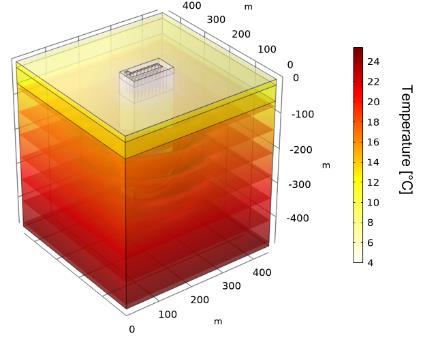
Tasks
- Literature review Conduct a comprehensive literature review related to the technical aspects of each project, such as borehole heat exchangers, machine learning techniques, or thermo hydro mechanical behavior in energy systems
- Numerical model development and validation: Develop and validate numerical models tailored to each project’s requirements, allowing for detailed analyses of the respective energy systems
- Advanced analysis techniques Depending on the selected project, perform
numerical sensitivity analyses, devise machine learning techniques, or carry out thermo hydro mechanical analyses to identify key performance parameters.
Contact:
Dr. Elena Ravera ( elena.ravera@epfl.ch )
Nuclear Waste Storage
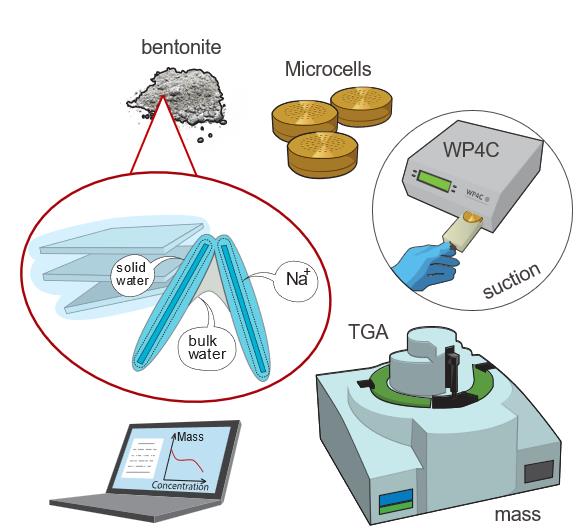
Tasks
- Experimental setup: Prepare bentonite samples and place them into Microcells. Submerge these samples in solutions with varying concentrations of salt, which is known to affect the quantity of adsorbed water.
- Data collection: Perform two primary measurements – suction using the WP 4 C device and the mass of adsorbed water using Thermogravimetric Analysis (TGA). These measurements will provide key data on the influence of different salt concentrations on water adsorption in bentonite.
- Chemical state analysis: Evaluate the characteristics of adsorbed water in various chemical states This analysis will help us understand the nature of “solid” water and how it is influenced by the presence of salts.
- Data analysis and modeling: Analyze the collected data and develop models to represent the obtained curves This modeling part is crucial for interpreting the experimental data and for understanding the mechanisms of water adsorption in bentonite.
Contact: Svetlana Babiy ( svetlana.babiy@epfl.ch )
Among the abilities of a geotechnical engineers is the capacity to create geomaterials with tailored properties, able to respond to demanding functional requirements while integrating economic and environmental considerations.
A new material must be developed that will seal the dozens of kilometers of tunnels to be excavated to build the Swiss Nuclear Waste Repository. The repository will be built at a depth of around 800 m and will host spent uranium fuel from the Swiss nuclear plants. To isolate the nuclear waste from the biosphere until its radioactivity decays to harmless levels (after tens of thousands of years!), an appropriate sealing material is required. Interestingly, the tons of clays that will be excavated to create the tunnels are potentially good ingredients for the mix design of the geomaterial to be conceived for the seal. The opportunity to reuse the excavated clays enhances the sustainability of the repository’s build.
The master project focuses on optimizing the mix design of this new sealing material and combining the excavated clay with other materials such as sands and bentonites. The aim is to create an engineered material with favorable hydro-mechanical properties in terms of stiffness, strength, retention capacity, and permeability to gas and water. The student will run advanced geomechanical experiments to test those properties under extreme conditions and will work on a constitutive model of the behavior of the new geomaterial.

Contact : Dr. Alessio Ferrari ( alessio.ferrari@epfl.ch )
Bio-Improved Soils

Tasks:
- Understand the current modeling framework and its limitations. Understand the meaning of all modeling parameters. Based on a literature review, make an overview of all parameters and their commonly used values and constraints.
- Define which experimental results to calibrate the model against. The experiments were performed in a large-scale setup; therefore, different results on the respective chemo and hydro components are available.
- Select a suitable model calibration method and evaluate different options for the sensitivity analyses and their feasibility. Inspiration can be taken from Saltelli (2004) and Wojnarowicz (2024).
- Perform model calibration and conclude on the best model parameters to represent the experiments performed. Demonstrate the influence of the different model parameters on the obtained results and highlight where the model has difficulty representing the experimentally obtained results.
Contact: Sofie ten Bosch ( sofie.tenbosch@epfl.ch )
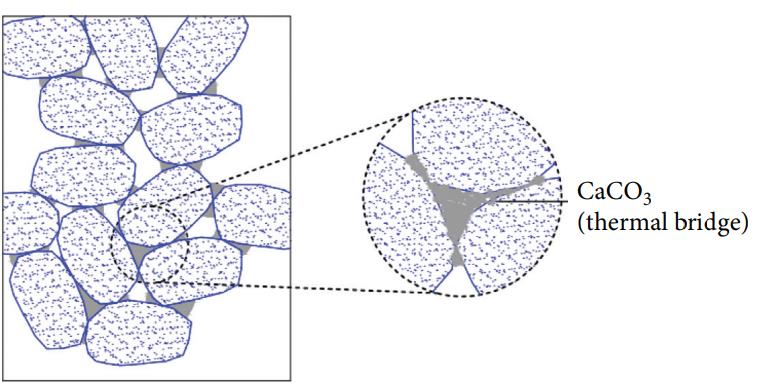 |
Wang et al. (2019) |
Tasks:
- Experimental analysis of calcite distribution impact: conduct laboratory experiments to evaluate the effect of calcite distribution pattern on the thermal conductivity of samples This includes assessment of untreated, treated intact, and treated remolded samples, focusing on the role of bonding and densification effects.
- Correlation of calcite distribution and thermal conductivity. determine the relationship between thermal conductivity and calcite distribution in the soil using shear wave velocity and 3-D scanning of samples The goal is to identify how calcite distribution affects thermal conductivity, potentially providing a quick indicator for efficiency in field applications.
- Development of a thermo hydrochemical modeling framework: extends a current modeling framework that links the thermal aspects of MICP with existing hydrochemical models This integrated model will simulate the effects of MICP treatment on heat transfer processes in energy geostructures.
- Assessment of MICP Influence on energy pile efficiency: use the developed modeling strategy and a 3-D model to evaluate the impact of MICP injections on the efficiency of an energy pile.
Contact: Ziad Sahlab (ziad.sahlab@epfl.ch ), Sofie ten Bosch ( sofie.tenbosch@epfl.ch )
CO2 Storage
Design and build a system for the temporary storage of CO2 following its capture (from the atmosphere or at the gas boiler outlet). It will be necessary to define the conditions in which the CO2 must be present (pressure, temperature, gas/liquid, etc.) in order to introduce it into the reservoir with the minimum of energy. Finally, a system for preparing analyzable samples from the CO2 stored in the temporary reservoir will have to be developed. This will be used to carry out analyses and burial tests with captured CO2 under real-life conditions.
Skills required: physics, chemical engineering, electrical engineering.
Bonus: laboratory experience.
Contact: Dr. Eleni Stavropoulou (eleni.stavropoulou@epfl.ch)
Characterize the geological system for CO2 injection and permanent storage: a superposition of a porous layer called “reservoir rock” used for CO2 storage, topped by an impermeable layer called “cap rock” used to prevent CO2 from rising to the surface. To be characterized, the “breakthrough” properties of the cap rock and the volume/capacity of the porous rock will need to be determined.
Skills required: physics, porous media mechanics, civil/environmental engineering, basic Python programming.
Bonus: laboratory experiment.
Contact: Dr. Eleni Stavropoulou (eleni.stavropoulou@epfl.ch)
Study the impact of CO2 on its environment after injection into a geological reservoir. Emphasis will be placed on determining the influence of the interaction of CO2 with the geomaterial in contact and the impact on the microstructure of this material. This interaction may be linked to possible chemical interactions with certain minerals in the rock, the introduction of CO2 overpressure or other factors.
Skills required: physics, civil/environmental engineering, mechanical engineering, Python programming.
Bonus: laboratory experience, 3D image processing.
Contact: Dr. Eleni Stavropoulou (eleni.stavropoulou@epfl.ch)
Model the injection of CO2 into a geological formation and understand the propagation of the injected fluid in time and space. In addition, determine the optimum conditions under which the carbon dioxide should be located.
Skills required: Finite element modeling (FEM), physics, thermodynamics, mechanical engineering.
Contact: Dr. Eleni Stavropoulou (eleni.stavropoulou@epfl.ch)
In Iceland, CO2 is injected into basalt formations for permanent storage. CO2, dissolved in water, reacts with favorable minerals in the rock to create new minerals and store carbon dioxide via mineralization. Precipitated zones preferentially form along existing conduits or fissures in the rock material. To better understand the formation of mineralized zones and their impact on pore connectivity in basalts, the micro-structure of a real basalt core precipitated in Iceland will be analyzed in 3D using X-ray tomography.
Skills: physics, chemical engineering, civil engineering, basic Python programming.
Contact: Dr. Eleni Stavropoulou (eleni.stavropoulou@epfl.ch)
Climate Change Impacts
Climate change is causing soils to experience unprecedented cycles of wet and dry states. Little is known about the impact of these variations on the hydraulic state of soil-structure interactions, particularly on possible changes in the lateral thrust on retaining structures.
The master project focuses on developing modeling tools to anticipate the evolution of the stability of structures that retain soils under variable environmental conditions.
The work will include an experimental component in which the student will use a physical model of a retaining structure already available in our laboratory, which can measure the lateral earth thrust exerted by soil. The soil can be artificially dried or wetted by rainfall to reproduce environmental fluctuations such as degree of saturation. The profile of pore water pressure (positive or suction) can be monitored thanks to an advanced system of tensiometers integrated into the physical model.
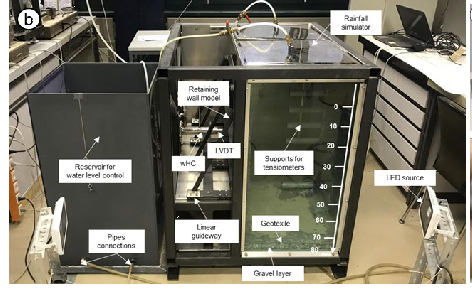
The results from the experimental work will serve as a basis for developing analytical solutions to compute the lateral thrust on retaining structures based on current and future trends of rainfall patterns. The developed solutions will serve to assess if existing structures can be considered safe or not, now and in the future.
Contact : Dr. Alessio Ferrari ( alessio.ferrari@epfl.ch )
Projects in industry

- Design and analysis of thermal piles in building foundations
- Assessment of energy potential in tunnels
More information is available at: https://geoeg.net/
Contact: Dr. Elena Ravera ( elena.ravera@epfl.ch )
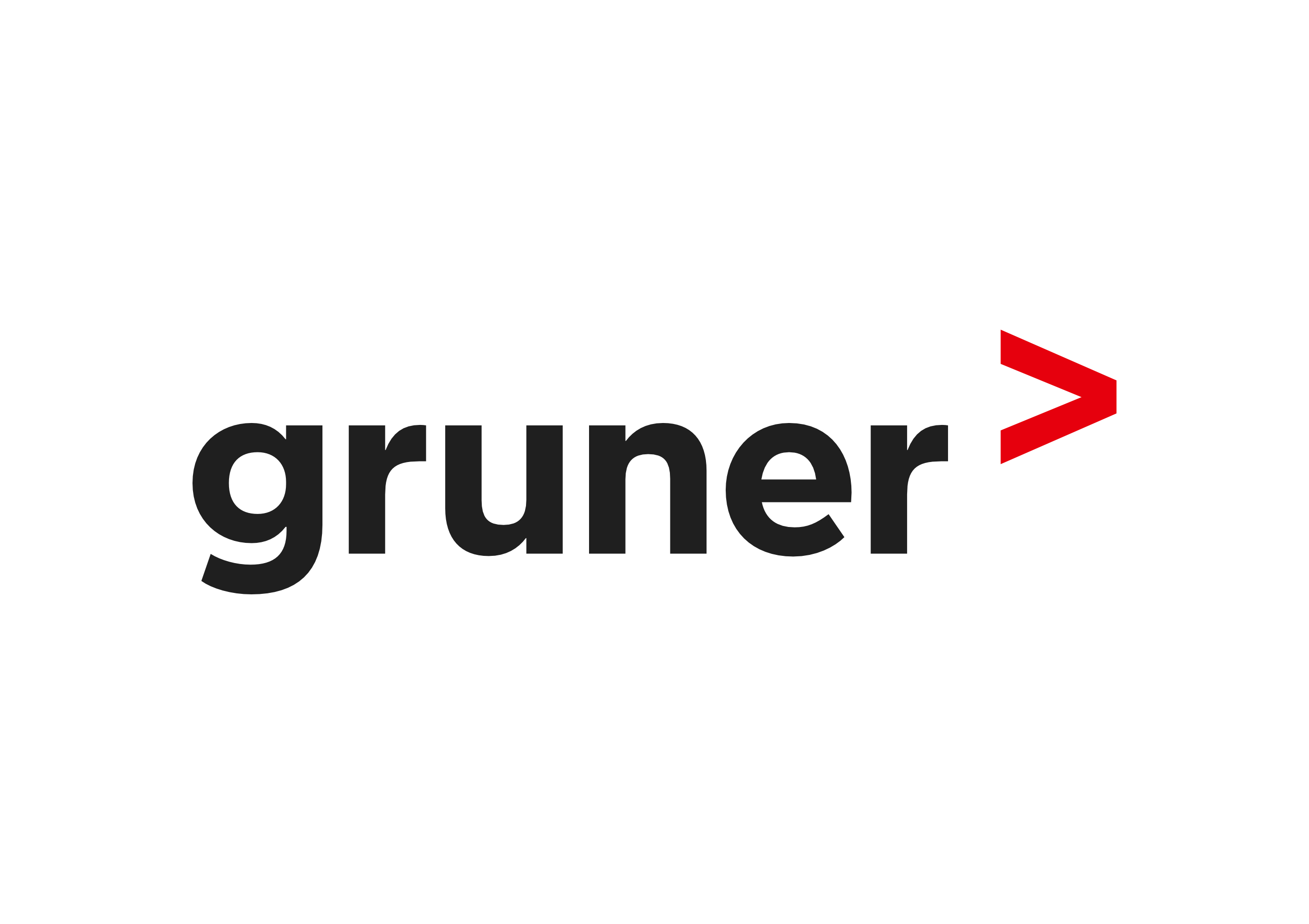
Tasks
- Novel methodology development: Formulate a new theoretical approach for applying loads on retaining walls considering soil elasto-plasticity.
- Script development for loading scenarios: Develop scripts tailored for each loading scenario, enhancing the versatility of the analysis.
- Elasto-plastic methodology design: Devise a unique elasto-plastic methodology to supplement the theoretical approach.
- Calculation tool creation: Build a comprehensive tool that integrates the novel methodology for efficient and accurate analysis of retaining walls under external loads.
Contact: Angelica Tuttolomondo ( angelica.tuttolomondo@gruner.ch ), John Eichenberger ( john.eichemberger@gruner.ch )

- Road and rail tunnels in urban and rural areas.
- Complex geotechnical infrastructure.
More information is available at: https://bg 21.com
Contact: Prof. Lyesse Laloui ( lyesse.laloui@epfl.ch )
Propose your own project
- Students are also encouraged to propose their own projects in the context of the laboratory activities.
More information is available at: https://www.epfl.ch/labs/lms/
Contact: Prof. Lyesse Laloui ( lyesse.laloui@epfl.ch )
Ongoing master projects:
- Marie Dupont: Etude géotechnique de la patinoire du Trèfle Blanc.
- Paolo Mansour Constitutive modeling of clayey geomaterials accounting for multistructural fabric levels
Completed projects:
- Cesare Griner: Hydromechanical impact of CO2 mineralization in Basalts.
- Lisa Laurent: Etude de performance et comparatif des possibilités de couplage du système Enerdrape avec d’autres systèmes énergétiques.
- Anne-Sarah Amblard: Self-sealing properties of shales for geological CO2 storage.
- Rémy Vallot: Machine learning for optimization of geomechanical modeling.
- Judith Gouin: Étude géotechnique de la section Plaines-du-Loup – Blécherette du métro m3 de Lausanne.
- Benjamin Schenk : Etude géotechnique et géotermique de la station et du tunnel de Beaulieu pour le M3.
- Nicolas Richard : Thermo-hydro-mechanical behavior of energy barrettes (in collaboration with NU, Chicago).
- Thomas Wüthrich : District scale prediction and monitoring of subsurface waste heat flows (in collaboration with NU, Chicago).
- Youssouf Lebbar : Thermo-hydro-mechanical behavior of energy barrettes. Case study : Testimonio II Tower, Monaco (in collaboration with NU, Chicago).
- Silvestro Massaro : Numerical modelling of energy piles. Assessment of the thermal resistance of different piles and soil configurations (in collaboration with Grenoble University).
- Mohamad Zaarour : Engineered Geothermal Systems-Hydraulic Fracturing and Induced Seismicity.
- Heloïse Fuselier : Experimental study on density of shales for engineering applications (Minnesota).
- Gaetan Gindrat : Risk analysis in natura hazards.
- Stephane Hartmann : City-scale application of energy geostructures (Chicago).
- Katinka Meyer : Geotechnical analysis in the area of Istanbul (Turquie).
- Matthias Wojnarowicz : Thermo-hydro-mechanical behavior of energy tunnels (Chicago).
- Fikret Can Yilmaz : Entreprise Risk Management & Civil Engineering Consulting Firms in Switzerland.
- Michela Casanova : Essais triaxiaux cycliques thermo-mécaniques (MIT).
- Michela Lagioia : Thermal efficiency of energy piles: validation of a new finite element for non-isothermal pipe-flow simulations.
- Mohamed Nadeem : Analyse et gestion des risques dans la planification d’un projet de Génie Civil – Approche par BIM 5D.
- Qazim Llabjani : Soil-structure interaction of energy walls based on spring models.
- Simon Caldi : Nouveau port de plaisance à Yverdon-les-Bains.
- Yannick Fessler : Tunnel en terrain meuble – métro m3 de Lausanne entre le Flon et la Blécherette.
- Arabelle Calliope De Saussure: A comparison of induced seismic events caused by hydraulic fracturing in engineered geothermal systems (EGS) and shale reservoir exploitation (MIT).
- Stefano Giovanni Pierre Cingari: Etude de faisabilité de géostructures énergétiques dans les gares – Application au grand Paris express.
- Benoît Claude Henri Cousin: Etude de faisabilité de géostructures énergétiques dans des tunnels.
- Grégoire Marie Maxime Aguettant: Etude du washboard – Etude des interactions roue-sol.
- Nicola Matias Schmid: Etude géotechnique de l’extension de l’aménagement hydroélectrique de Lavey.
- Margaux Marie Valérie Peltier: GSHP Application for Heating and Cooling at “City Scale”.
- Nicolas Delessert: Tranchée couverte d’une ligne de chemin de fer à Monthey et dans l’agglomeration.
- Ray Harran: Decision Aids for Tunneling: A Catalogue for Application to Small Tunnels (MIT).
- Andrea Caldirola: Characterization of unsaturated soil parameters for soil-structure interaction.
- Mattia Dell’Acqua: Numerical modelling of the seismic response of earth dams.
- Annik Schaufelberger: Design of an energy tunnel
- Christopher Tomcik: Caractérisation thermique d’un système de captage et valorisation de chaleur fatale en milieu souterrain
